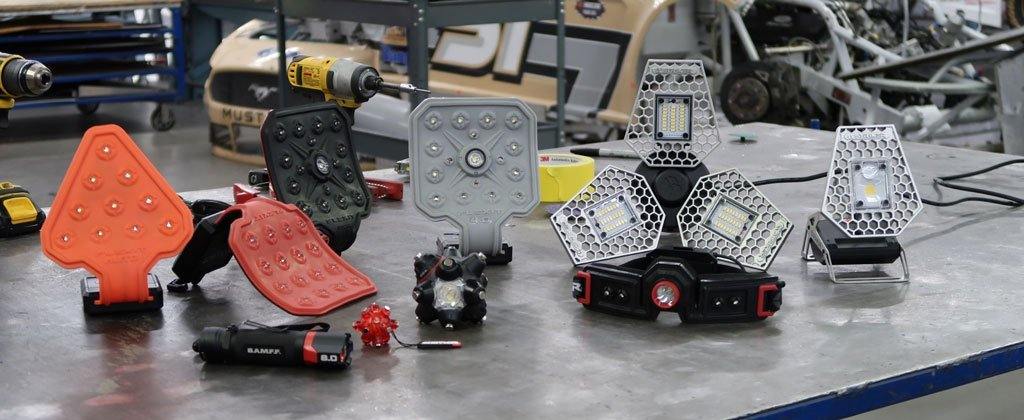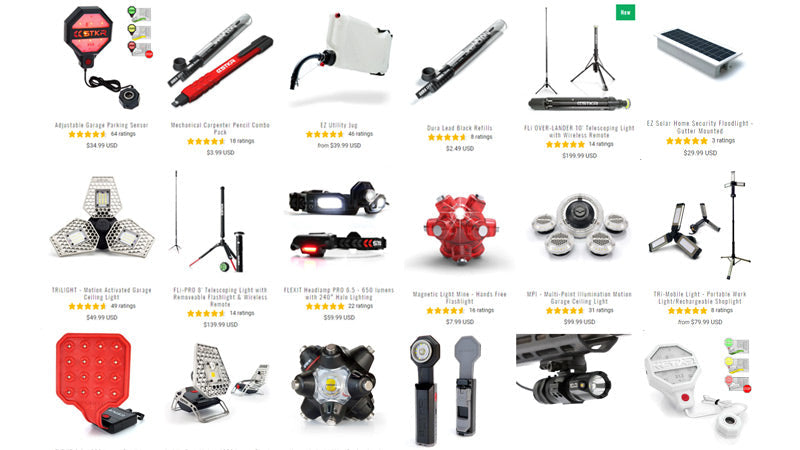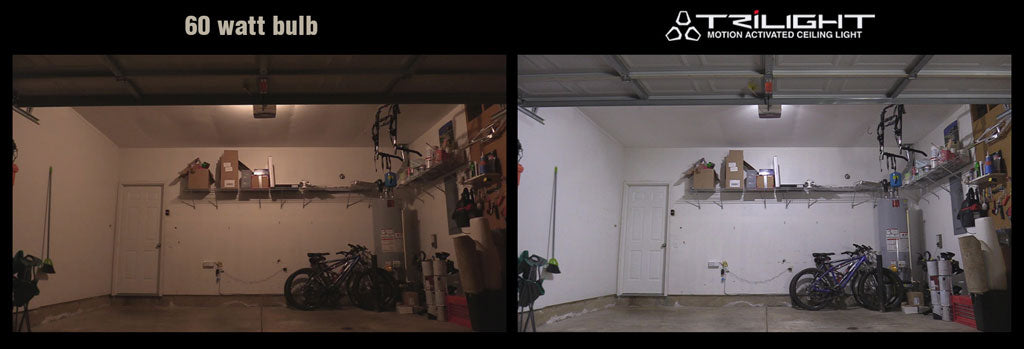
How Many Lumens Do You Need for a Work Light?
Share
When working on any project, you’ll need a lighting source to do the job efficiently, whether it’s candles (hello 1800’s), natural light (great for the daytime or outdoor jobs), or a lightbulb of some sort. Obviously, in today’s society, candles are left for romance and lightbulbs are the most common source of illumination. But when it comes to figuring out what type of work light or how many lumens it needs, the answer isn’t always cut and dry.
The number of lumens you need for a good work light can range between 100 and 5,000. The exact amount of lumens you need for your work light depends on the size of your project, location, and the environment you are working in.
If you are looking for a full garage lighting system, you will need to search out lights emitting 2000-10,000 lumens.
You may be thinking that it doesn’t matter what type of bulb you use for your workspace, but there are many factors at play - wattage, bulb type, heat, battery life or power source, the spread of light, and especially lumens.
Be warned, Lumens is also the area where non-branded, cheap, copy lights also fudge their numbers to make the sale. Lights claiming more lumens are available, but few on the market truly put out what they claim. Be sure you trust the brand you are buying from to ensure you get what you are paying for. With lights, just like most things in life, you get what you pay for.
The rest of this article will explain what lumens are and how they impact certain spaces, how to calculate how many you’ll need for your workspace, and the different lumen requirements for different types of spaces.
What Are Lumens?

To define lumens we refer to a basic definition: “a unit of luminous flux in the International System of Units, that is equal to the amount of light given out through a solid angle by a source of one candela intensity radiating equally in all directions.”
If that made sense to you, then hello light nerd...not an insult, we are lighting nerds too. If that didn’t make sense, you aren’t alone. Basically, lumens equals brightness!
Lumens are a unit of the SI derived unit of luminous flux, a measure of the total quantity of visible light put out by a source per unit of time. They are what give a bulb its brightness, and are measured by how much visible light they give off.
When you think of a lightbulb, likely the first thing that comes to mind is the watts. Unlike lumens, watts are not used to measure the brightness of a bulb. Not that watts are bad, but they measure energy use, not light output. With new, energy-efficient LED technology, we can no longer rely upon wattage to indicate how bright a bulb is.
You might also like: How Many Lumens Should a Good Flashlight Have?
How Many Lumens Do You Need?
That is like asking how much horsepower your car needs. It depends on you and the job you want your car to accomplish. It also depends on your environment. If you are working in a large open space, you will need more lumens, if you are working in a finished space with white walls and ceiling, you will need less because the lighting will reflect off of the clean bright surfaces. Also, the number of points of light is very important. The larger the space, the more points of light you need to reduce shadows.
There are a lot of articles on the web all claiming you need 60-1,000 lumens per square foot, but this calculation is insane. You would burn out your retinas!
We think it is helpful to just give the reader a perspective that they can relate to. A standard 60 watt incandescent bulb produces approx. 800 lumens. So, picture one lonely 60 watt bulb in a room or your garage, and you will have a foundation and expectation of light and lumens.

Many 2 car garages, the biggest room in your house, are often wired with only one light bulb. If you want to use the example above of one 60 watt bulb putting out 800 lumens, and convert that to lumens per sq ft, then an average 2 car garage (22’ x 22’ = 484 sq ft) would average out to 1.65 lumens per square foot. For some families, that is just fine to park the car in and forget about. However, if you want to work in your garage you will need much more.
To best determine how many lumens, you first have to determine what lighting is right for your garage. Are you building a new garage? Are you rewiring an existing garage? Are you hoping to use the existing light fixtures? Using what you have will ultimately be the quickest and easiest options. Good lights that use your existing fixtures may cost more up front, but they will save much more money in electrical wiring, electrician fees, and additional parts.
If you are trying to simply use the existing light fixtures that are already wired into your garage, and avoid any electricians or wiring fees, your best bet is lighting by STKR Concepts. They make a couple options that will light an entire garage with no electrical wiring required. More on those models later in this article.
Once common step to determine lighting needs, especially for new builds or remodels is to simply determine the size of the garage you want to light. Follow the below steps to determine the best lighting situation for your workspace.
Measure the Square Footage of Your Room

Square footage plays the one of the biggest role in determining how many lumens will be sufficient for your workspace. To measure the square footage, complete these steps:
- Measure the length of your room
- Measure the width of your room
- Multiply the length and width to get the square footage
For example, say you have a one car garage that is on average 12 feet long (3.65 meters) by 22 feet wide (6.7 meters), you would multiply 12 x 22 to get 264 square feet (24.5 square meters).
Now that you have the size of your garage, determine where you want the light. If you have work areas or work benches, you may want to wire up different areas of the shop differently. Also, be aware of your garage door. When it is up, you may be covering up your lighting.
You might also like: How Many Lumens Do You Need to Light a Garage?
Basic rule of thumb if wiring a new garage is to combine quality lights that emit realistic and honest lumen claims, and add multiple locations if possible. This will give your garage the fullest, most usable light with the least amount of shadows. If you don’t have the opportunity to add more locations, push for better lights and higher lumen output per light.
Use the chart below as a starting point. If you have a finished garage with white drywall on walls and ceiling you can get by with less lumens. If you have open rafters and unfinished walls, your garage will absorb a lot of light requiring you to install more lights with higher lumen ratings.
|
Minimum Lighting Suggestions for the average garage |
||
|
Garage Size / Area |
Minimum # of quality lights |
Minimum Lumen Recommendation |
|
1 car garage (264 sq ft) |
1-2 |
4,000-6,000 |
|
2 car garage (484 sq ft) |
2-4 |
6,000-10,000 |
|
3 car garage (704 sq ft) |
3-6 |
8,000-12,000 |
|
3 car garage (704 sq ft) |
4-8 |
10,000-15,000 |
|
Just like the car analogy above, garage lighting is like cars & horsepower, you can never have too much! :) Above is minimum recommendations, but you can always go with more! |
||
Lumen Requirements for Different Workspaces

Your lumen requirements are going to change depending on what you’re using the space for, and with that change will come different lighting requirements altogether. Areas where you’re doing detailed work, like over a workbench in a garage, will require many more lumens than your large open space of the garage. For example, spaces 1,6,4,2 in the image above might require more lighting as main focal or traffic points. Area 3 and 5 may not require as much due to secondary storage. If you’re working outside, especially at night, those lumen requirements go up significantly since you won’t have walls to reflect the light.
Garage Lighting Requirements
Good ceiling lighting is a must

If you use your garage for more than just parking your car, you are going to want to ensure you give yourself a good “lighting canvas” to start with. Make sure you have good ceiling lights, and multiple locations if possible. Also, if your garage is unfinished, and you want good light, you might consider finishing the walls and ceiling, and painting them a light color. That is a bit of an investment, but will actually go a long way in making your garage a bright place to work! Good lighting, finished walls, finished ceilings...all of this will add up, so you may opt to save money on an electrician and just use the existing ceiling light fixtures your garage already has. Many garages come prewired with Edison bulb fixtures and a lousy light bulb. If that is what you have, don’t fear! There is a great lighting option for you!
The TriLight Shoplight by STKR Concepts is a perfect solution for a garage because it can simply be installed into your existing light bulb fixture! It offers 4000 lumens per device and also has an adjustable microwave motion sensor. This motion activated LED garage ceiling light will give off more than enough bright white light to allow you to tackle any job. Beware of cheap Chinese copy lights. Since STKR invented this garage lighting system, Amazon and other marketplaces have been flooded with cheap copies that make false claims about quality, warranty, watt usage, and lumens. STKR is the original, is based in North Carolina, USA, and has been developing innovative garage lights and work lights for over 15 years.
You might also like: How Many Lumens Do You Need for a Work Light?
Full Garage Lighting Systems
If you’re looking for a complete garage lighting system for your garage ceiling that can be installed in minutes, the Multi-Point Illumination System by STKR Concepts is a perfect fit. With this system, you get 7500 lumens and 5 points of illumination to canvas the entire garage space with light. You can install it in minutes without an electrician using the existing light bulb fixture in your garage, making it a quick and efficient solution for your garage, attic, or any other space you may need it. It also comes with an adjustable motion sensor and USB power for security cameras.
On the Go Mobile Work Lighting
Even if you have the best lit garage in your neighborhood, you are going to eventually need some mobile work lighting. If you’re looking for something hands-free and incredibly versatile, look no further than the FLEXiT Line of lighting by STKR Concepts. Our favorite, and the most powerful, is the FLEXIT Solar 500 Lumen Flashlight. This powerful flexible flashlight is fueled by solar power so that you can take it anywhere you need to go without worrying about it losing power. It’s also got powerful magnets, or can be wrapped, hooked, and hung on anything. You can then aim the panel of LEDs directly at your project, which will allow you to have hands-free light whenever you need it.
Outdoor Requirements
Sometimes you find yourself with an outdoor project, and forced to work at night. If you’re looking for light outside, you’ll want something portable and easy to maneuver, without sacrificing the lumens you need to see clearly.
If you still have access to power, you can plug in the Trilight Shoplight. This is the most powerful, modern-day LED shop light. Often called a droplight, this blazingly powerful light will light your entire outdoor project, or even your entire yard if you need it to! The three aluminum heads can be aimed independently to offer 360-degree lighting or focus all 3000 lumens in one direction.
If you need something mobile, opt for the STKR Mobile Task Light. It uses the same Aluminum head as the Trilight but is powered by dual lithium batteries that are easily recharged using the micro USB port. The Mobile Task Light by STKR is one of the brightest rechargeable lights on the market boasting 1200 lumens of light and a dual output lens. Other lights may claim more lumens, but STKR pushes the limits of LED tech to ensure you are getting what you pay for.
If you want something more traditional regarding a handheld flashlight, the B.A.M.F.F 6.0 600 Lumen Dual LED Flashlight is a great option. It has dual LED lights that can be used one at a time or together, offering excellent long-distance lighting as well as wide-angle floodlight for close-range lighting. With its Dual LED technology plus rugged tactical flashlight design, the B.A.M.F.F. line of flashlights stand out in a market flooded with “me too” flashlights.
Final Thoughts
Numerous factors come into play when determining how many lumens you need for a work light, or an entire garage.
Larger spaces will require multiple lights to acquire the correct lumen count, and you could benefit by ensuring the space you are trying to light has finished walls and ceilings with a bright finish.
If you need something more portable than a garage ceiling light, Lights that plug into wall outlets will offer more lumens, but smaller battery powered work lights with lower lumen counts are better for truly mobile options. Flashlights or devices that can mount to any surface you’re working on and easily aim at your workspace or project will still allow you to work hands-free. In fact, some of these hands free work lights also double as the best handheld flashlights, making them a very usable and versatile option.












